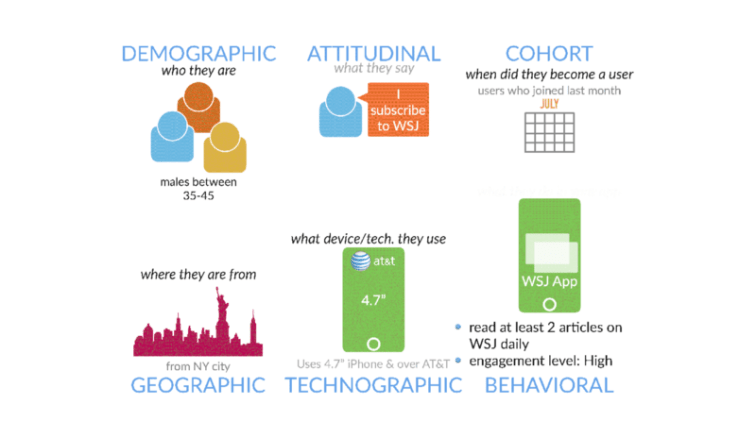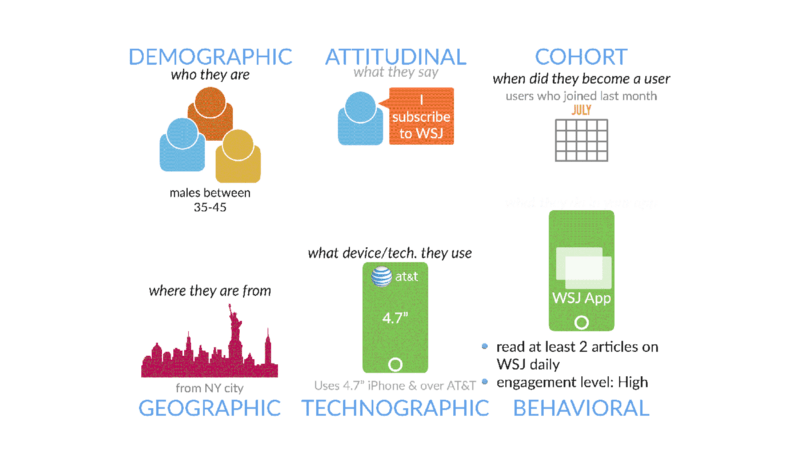Relying on demographic, geographic, technographic or psychographic segmentation alone?
Sorry, you missed the candy-crush-saga-playing 76yr old male & calculus-loving 11 year old girl.
Users want exhilarating digital experiences that match in-person experiences that we have known to love. Businesses strive to build meaningful one-on-one relationships with users and over time attempt to affect behavior towards achieving desired outcomes. Businesses do so by personalizing every interaction point and experience, including content feeds, user interfaces, communications, and promotion of products.
Need for segmentation of users
Every user is different. Building one-on-one relationships using traditional analytics is not possible in environments where an app or a service can have millions of users. Identifying users by segmenting them into niche groups of users who have common needs, interests, goals, and priorities are useful to achieve the effectiveness of promotions and communications for users within the same segment.
General Segmentation Techniques
General techniques used for segmentation include demographic, geographic, cohort groupings, technographic, psychographic, attitudinal, needs-based, outcome-based and behavioral segmentation. Let’s start with a recap various segmentation and targeting techniques used today.
Demographic Segmentation
“who they are.”

If an e-commerce site wants to target to shoppers, you may think of women between 26 and 42 as a primary segment to target.
Marketers have known and incorporated Demographic (age, gender, income group, etc.) and geographic segmentation in their strategy since the 1950s as it was easily collectible for radio advertising. Demographic segmentation’s effectiveness is questionable as competitors can easily copy it. See why relying on demographics alone is limiting in this well-researched Think with Google article.
Organizational Demographic Segmentation
“who they work for.”
Organizational demographic is a segmentation technique that brings the enterprise into the mix. Segmenting based on the industry, organization revenue, the number of employees, along with of the employees: diversity, age, tenure, education level of employees yields insights into organizational behavior.
Technographic Segmentation
“what technology do your users use.”

Segmenting based on how users are using your product based on the technology they use: model, manufacturer, the size of the screen, cellular carrier and connectivity, etc. For example, people using Apple iPhone with AT&T versus people using a value phone over MetroPCS.
Cohort Segmentation
“when did they become a user.”

Segmenting based on a monthly or weekly cohort. For example, users who joined last month.
Geographic Segmentation
“where are they from.”

Segmenting users based on their geo-location, locale or region, for example, people from NY are more likely to sign up for weather alerts in winter.
Attitudinal Segmentation
“what users say”

Segmenting based on user’s expressed beliefs. For example, people who responded to a survey saying they have a subscription to WSJ. On mobile, it is much harder to ask survey-like questions.
Polls and rating are typical, but why ask if you can figure it out? An app, for instance, should not ask anything it could work out using sensors available on a mobile device. Device sensors profoundly change what an app can know.
Psychographic Segmentation
“what are their values, interests, opinions, and lifestyles.”

Segmenting based on users values, beliefs, and lifestyle. For example, people who use fitness apps, or have a huge music collection or have multiple photography apps. Psychographic data is not always attitudinal, i.e. collected as an expressed belief. For instance, an app can collect psychographic data based on what users click on in a content feed.
Needs-based Segmentation
“what do they need.”
Needs-based segmentation involves segmenting users based on what users need or what product features and benefits were most appealing to them. For example, people from Boston who live in the suburbs may indicate that they need snow removal tools. The needs of users can be collected using surveys or detected based on likes and visits to items of interest.
Outcome-based Segmentation
“what outcomes you want from users.”

Outcome-based segmentation is advantageous as it enables segmenting users based on what outcomes businesses and brands want to achieve from each segment. A group of users that may be okay spending (via in-app purchases) on filters and another segment may be perfect for sponsored filters. Segments are differentiated from feature-driven needs-based segmentation.
Motorola, for example, used three market segments for its radio product: Discrete and covert communications (e.g. FBI, CIA), communications in life-threatening situations (e.g. Fire fighting), and communications for administrative tasks (e.g. organizing an event). Market segments may have overlapping needs (e.g. longer lasting battery).
Behavioral Segmentation
“how users behave and what they do, in your product.”

- Do they respond to specific push notifications and in-app messages?
- Do they research before buying on an e-commerce website?
- What purchases have they made in the past?
- How many positive and negative experiences have they had in the past
- How many support tickets have the opened in the last three months?
- For example, people who are engaged with your service and read at least two articles on a daily basis.
What users are doing in your product is a much better way to determine important segments than demographic, geographic, technographic or psychographic segmentation alone.
Targeting users based on their behavior in your app or product in conjunction with who they are, where they are from, what devices and technologies they use, is a win-win for both marketers and users.
Marketers who try to reach their audience solely on demographics risk missing more than 70% of potential mobile shoppers — Mobile search & video behavior analysis, Millward Brown Digital, U.S., January-June 2015


2 thoughts on “✨ Why relying on conventional segmentation techniques alone can be detrimental to growth”
Comments are closed.